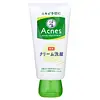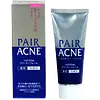What's inside
What's inside
 Key Ingredients
Key Ingredients

 Benefits
Benefits

 Concerns
Concerns

 Ingredients Side-by-side
Ingredients Side-by-side

O-Cymen-5-Ol
AntimicrobialDipotassium Glycyrrhizate
HumectantCetyl Phosphate
EmulsifyingEcklonia Stolonifera Extract
EmollientOlea Europaea Fruit Oil
MaskingGlycol Stearate
EmollientLauric Acid
CleansingMyristic Acid
CleansingPalmitic Acid
EmollientTocopheryl Acetate
AntioxidantN-Lauryl Diethanolamine
Lauryl Hydroxysultaine
CleansingLauroyl Glutamic Acid
Skin ConditioningGlycerin
HumectantAnhydroxylitol
HumectantButylene Glycol
HumectantLactic Acid
BufferingPotassium Chloride
CI 77288
Cosmetic ColorantCI 77492
Cosmetic ColorantPotassium Hydroxide
BufferingSodium Hydroxide
BufferingParfum
MaskingO-Cymen-5-Ol, Dipotassium Glycyrrhizate, Cetyl Phosphate, Ecklonia Stolonifera Extract, Olea Europaea Fruit Oil, Glycol Stearate, Lauric Acid, Myristic Acid, Palmitic Acid, Tocopheryl Acetate, N-Lauryl Diethanolamine, Lauryl Hydroxysultaine, Lauroyl Glutamic Acid, Glycerin, Anhydroxylitol, Butylene Glycol, Lactic Acid, Potassium Chloride, CI 77288, CI 77492, Potassium Hydroxide, Sodium Hydroxide, Parfum
Dipotassium Glycyrrhizate
HumectantO-Cymen-5-Ol
AntimicrobialMyristic Acid
CleansingGlycerin
HumectantDipropylene Glycol
HumectantCoconut Oil Decyl Esters
Skin ConditioningPotassium Hydroxide
BufferingPalmitic Acid
EmollientN-Lauryl Diethanolamine
Sorbitol
HumectantPEG-150
HumectantGlycol Distearate
EmollientParfum
MaskingEDTA
Butylene Glycol
HumectantTocopherol
AntioxidantMagnesium Phosphate
StabilisingGlycine Soja Extract
Skin ConditioningSodium Paraben
PreservativeDipotassium Glycyrrhizate, O-Cymen-5-Ol, Myristic Acid, Glycerin, Dipropylene Glycol, Coconut Oil Decyl Esters, Potassium Hydroxide, Palmitic Acid, N-Lauryl Diethanolamine, Sorbitol, PEG-150, Glycol Distearate, Parfum, EDTA, Butylene Glycol, Tocopherol, Magnesium Phosphate, Glycine Soja Extract, Sodium Paraben
 Reviews
Reviews

Ingredients Explained
These ingredients are found in both products.
Ingredients higher up in an ingredient list are typically present in a larger amount.
Butylene Glycol (or BG) is used within cosmetic products for a few different reasons:
Overall, Butylene Glycol is a safe and well-rounded ingredient that works well with other ingredients.
Though this ingredient works well with most skin types, some people with sensitive skin may experience a reaction such as allergic rashes, closed comedones, or itchiness.
Learn more about Butylene GlycolDipotassium Glycyrrhizate comes from licorice root.
Extracts of licorice have demonstrated to have antibacterial, anti‐inflammatory, antiviral, antioxidant properties.
One component, glabridin, has extra potent antioxidant and soothing properties. It has also been found to block pigmentation from UVB rays in guinea pigs.
Licorice Root also contains a flavonoid. Flavonoids are a natural substance from in plants. Flavonoids also have antioxidant properties.
Another component, glycyrrhizin, has been found to have anti-inflammatory and antimicrobial benefits. This may make licorice root extract effective at treating acne. However, more research is needed to support this.
Liquiritin is one of the flavone compounds found in licorice. It has been found to help lighten skin by preventing tyrosinase from reacting with tyrosine. When the two react, protein is converted to melanin. Melanin is the substance in your body that gives your features pigmentation.
Licorice root is native to Southern Europe and Asia. It has been used in traditional Chinese medicine to help with respiratory issues.
Learn more about Dipotassium GlycyrrhizateGlycerin is already naturally found in your skin. It helps moisturize and protect your skin.
A study from 2016 found glycerin to be more effective as a humectant than AHAs and hyaluronic acid.
As a humectant, it helps the skin stay hydrated by pulling moisture to your skin. The low molecular weight of glycerin allows it to pull moisture into the deeper layers of your skin.
Hydrated skin improves your skin barrier; Your skin barrier helps protect against irritants and bacteria.
Glycerin has also been found to have antimicrobial and antiviral properties. Due to these properties, glycerin is often used in wound and burn treatments.
In cosmetics, glycerin is usually derived from plants such as soybean or palm. However, it can also be sourced from animals, such as tallow or animal fat.
This ingredient is organic, colorless, odorless, and non-toxic.
Glycerin is the name for this ingredient in American English. British English uses Glycerol/Glycerine.
Learn more about GlycerinMyristic Acid is a saturated fatty acid. It is naturally found in milk fat. Other sources include palm oil, coconut oil, and butter fat.
Myristic Acid is an emulsifer and cleanser. As an emulsifer, it stabilizes a product by preventing ingredients from separating. Myristic Acid helps clean your skin by acting as a surfactant. It tends to gather oil and dirt on your skin to be easily rinsed away.
One study from 2021 found Myristic Acid to have anti-inflammatory properties.
Learn more about Myristic AcidWe don't have a description for N-Lauryl Diethanolamine yet.
This ingredient is more commonly known as IPMP or Isopropyl Methylphenol. It is a preservative and has antimicrobial properties.
According to the EPA, this ingredient is allowed for use in cleansers, creams, powders, bath products, toothpaste, perfume, and more.
Palmitic Acid is a fatty acid naturally found in our skin and in many plant and animal sources. In cosmetics, it is usually derived from palm oil. It serves many purposes in skincare, acting as a cleanser, emollient, and emulsifier.
As an emollient, palmitic acid helps soften and smooth the skin by preventing water loss. In cleansers, it helps remove oil and dirt while creating foam.
Its emulsifying properties help stabilize products by keeping water and oil-based ingredients from separating.
This may not be suitable for fungal acne-prone skin, as fatty acids like this can sometimes trigger breakouts in sensitive individuals.
Learn more about Palmitic AcidParfum is a catch-all term for an ingredient or more that is used to give a scent to products.
Also called "fragrance", this ingredient can be a blend of hundreds of chemicals or plant oils. This means every product with "fragrance" or "parfum" in the ingredients list is a different mixture.
For instance, Habanolide is a proprietary trade name for a specific aroma chemical. When used as a fragrance ingredient in cosmetics, most aroma chemicals fall under the broad labeling category of “FRAGRANCE” or “PARFUM” according to EU and US regulations.
The term 'parfum' or 'fragrance' is not regulated in many countries. In many cases, it is up to the brand to define this term.
For instance, many brands choose to label themselves as "fragrance-free" because they are not using synthetic fragrances. However, their products may still contain ingredients such as essential oils that are considered a fragrance by INCI standards.
One example is Calendula flower extract. Calendula is an essential oil that still imparts a scent or 'fragrance'.
Depending on the blend, the ingredients in the mixture can cause allergies and sensitivities on the skin. Some ingredients that are known EU allergens include linalool and citronellol.
Parfum can also be used to mask or cover an unpleasant scent.
The bottom line is: not all fragrances/parfum/ingredients are created equally. If you are worried about fragrances, we recommend taking a closer look at an ingredient. And of course, we always recommend speaking with a professional.
Learn more about ParfumPotassium hydroxide is commonly known as caustic potash. It is used to fix the pH of a product or as a cleaning agent in soap. In cleansers, it is used for the saponification of oils.
Sapnification is the process of creating fatty acid metal salts from triglycerides and a strong base. During this process, Potassium Hydroxide is used up and is not present in the final product.
Using high concentrations of Potassium Hydroxide have shown to irritate the skin.
Learn more about Potassium Hydroxide